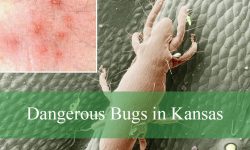Rodents in Michigan are abundant and play key roles in supporting the region’s natural environmental balance. From small mice darting through forest floors to large beavers transforming waterways, these animals thrive in diverse habitats such as woodlands, wetlands, fields, and urban settings. Learning to identify these common rodents and understanding their behaviors and habitats can enhance your connection to Michigan’s natural world.
This article presents 13 of the most common rodents found throughout Michigan, detailing their distinguishing features, unique habits, and preferred environments. For anyone interested in wildlife, this guide offers valuable insights into the fascinating lives of these important animals.
Types of Rodents in Michigan
Mice (House Mouse, Deer Mouse, White-footed Mouse)

Mice are small rodents, typically measuring about 3 to 4 inches in body length, with long tails that often equal or exceed their body length. The house mouse usually has a light brown or gray coat and is commonly found in human dwellings, where it thrives in close proximity to people. In contrast, the deer mouse is notable for its white feet and underbelly paired with large, dark eyes that give it a distinctive appearance. The white-footed mouse closely resembles the deer mouse but is generally smaller and more delicate in build, with subtle differences in fur color and size. These subtle physical traits help in identifying each species in the wild.
Mice are highly adaptable and extremely agile, known for their quick movements and ability to squeeze into very small spaces. Primarily nocturnal, they spend most daylight hours hidden in nests, burrows, or other sheltered places to avoid predators. Their behavior includes gathering and storing food to prepare for the winter months when resources are scarce. Mice are excellent climbers and swimmers, which allows them to evade many predators and access a variety of food sources, including stored grains and seeds in human homes and agricultural settings.
The diet of mice mainly consists of seeds, grains, fruits, and occasionally insects, making them opportunistic feeders that can adjust to whatever food is available. In Michigan, these mice are widespread across various habitats, including forests, grasslands, agricultural fields, and urban areas. They play a crucial ecological role as a food source for many predators, including hawks, owls, snakes, and mammals, thus forming an important link in the local food webs.
A fascinating fact about deer mice is their status as carriers of the hantavirus, a disease that can affect humans but is rarely transmitted directly. Despite this, deer mice are vital for the ecosystem because they help disperse seeds through their foraging activities and provide prey for numerous predator species. Their population dynamics also influence the abundance of other wildlife, making them key players in Michigan’s biodiversity.
Voles (Meadow Vole, Woodland Vole)

Voles are small, stocky rodents that generally measure between 4 to 8 inches in length. They have short tails and small ears, which are often hidden beneath dense fur, making them appear round and compact. Meadow voles typically have brownish fur with a lighter underside, while woodland voles have darker, more grizzled coats. Their blunt noses and rounded bodies set them apart from other rodents like mice, giving them a distinct appearance in the wild.
Voles are active throughout both day and night but often remain hidden beneath dense vegetation or within elaborate underground tunnel systems. They create complex networks of burrows and surface runways through grasses and underbrush, which help them avoid predators and harsh weather. Known for their high reproductive rate, female voles can produce multiple litters each year, leading to significant population fluctuations that impact local ecosystems.
Their diet is primarily herbivorous, focusing on grasses, roots, seeds, and the bark of shrubs and trees. In Michigan, voles thrive in grassy meadows, wetlands, and forest edges where they find ample ground cover to protect themselves. Although they sometimes cause damage to crops and gardens due to their feeding habits, voles play an essential role in nutrient cycling and serve as a primary food source for many raptors and carnivorous mammals.
One intriguing aspect of vole biology is their population cycles, which tend to rise and fall dramatically every few years. These fluctuations have significant effects on predator populations, especially hawks and owls that rely heavily on voles as prey. When vole numbers peak, predator populations often increase, and when vole numbers crash, predators must switch to other food sources or face declines themselves.
Rats (Brown Rat, Norway Rat, Roof Rat)

Rats found in Michigan are generally larger than mice, with body lengths ranging from 7 to 10 inches and long, scaly tails. The Brown rat, also known as the Norway rat, has coarse brown fur and is common in both urban and rural areas. It is a highly adaptable species capable of living in sewers, garbage dumps, and agricultural fields. The Roof rat, on the other hand, has sleeker black or dark brown fur and prefers warmer environments, often living in attics, roofs, and tree canopies.
These rodents are intelligent and social animals that typically live in colonies with complex social hierarchies. Mostly nocturnal, they are known for their strong, continuously growing teeth, which allow them to gnaw through wood, plastic, and even electrical wiring. Their behavior includes scavenging for food in diverse environments and building nests in protected areas like burrows, sewers, or within human structures.
Rats are omnivorous opportunists, consuming a wide variety of foods including grains, fruits, small animals, insects, and human food waste. Their ability to exploit a wide range of food sources contributes to their success in many environments. In Michigan, they are found across cities, farms, and industrial areas, where their adaptability has made them one of the most successful mammal species living alongside humans.
An interesting fact about Norway rats is their swimming ability; they can hold their breath for over 30 seconds and swim underwater for up to three minutes. This skill enables them to navigate flooded areas and sewer systems effectively, making them particularly hard to eradicate in urban environments.
Squirrels (Eastern Gray Squirrel, Fox Squirrel, Red Squirrel)

Squirrels are medium-sized rodents recognizable by their bushy tails, sharp claws, and agile climbing abilities. The Eastern gray squirrel sports gray fur with white underparts and is one of the most common species in Michigan. The Fox squirrel has a reddish-brown coat and is larger in size, while the Red squirrel features vibrant reddish-orange fur with a white belly and is generally smaller and more aggressive in behavior. These species range in size from about 9 to 20 inches long, including their distinctive tails.
These squirrels are primarily diurnal and spend much of their active hours foraging, climbing trees, and storing food to prepare for winter. Communication among squirrels includes loud tail flicks and chirping vocalizations. They build nests called dreys in tree branches or use natural tree cavities for shelter. Their behavior of caching nuts and seeds plays an important ecological role by aiding forest regeneration when some of these buried food items sprout into new trees.
Their diet consists mainly of nuts, seeds, fruits, and fungi, but they can also consume bird eggs and insects when available. Michigan’s abundant forests, parks, and suburban neighborhoods provide excellent habitats for these adaptable rodents. Their hoarding behavior not only ensures survival through the winter but also helps maintain healthy forest ecosystems.
A remarkable fact about Eastern gray squirrels is their ability to locate buried nuts even when covered by a foot or more of snow. They rely on a combination of an excellent sense of smell and spatial memory, demonstrating impressive cognitive abilities among rodents.
Ground Squirrels

Ground squirrels are robust rodents ranging from 7 to 12 inches in length, with shorter, less bushy tails compared to their tree-dwelling relatives. Their fur is typically brown or gray with spotted or striped patterns that provide camouflage in grassy and open environments. Unlike tree squirrels, ground squirrels spend most of their time on or below the ground, where they dig extensive burrow systems.
These animals are diurnal and well-known for their burrowing behavior. Their tunnels provide shelter and protection from predators and severe weather, and they often live in colonies with complex social interactions and communication through vocalizations and tail movements. Their social structure and cooperative behaviors help them survive in open habitats where cover is limited.
Ground squirrels feed on a varied diet that includes seeds, nuts, fruits, insects, and occasionally small vertebrates. In Michigan, they inhabit open fields, meadows, and grasslands where the soil is suitable for digging. Their burrowing activity also contributes positively to the environment by aerating the soil and providing shelter for other animals.
An interesting aspect of ground squirrels is their ability to hibernate during Michigan’s cold winters. During hibernation, they significantly reduce their metabolic rate, conserving energy until conditions improve in the spring. This adaptation allows them to survive harsh seasonal changes and emerge ready to reproduce and forage.
Chipmunks

Chipmunks are small, striped rodents measuring approximately 7 to 10 inches in length, including their bushy tails. Their most distinctive feature is the pattern of black and white stripes running along their backs and faces, which makes them easily recognizable among other small mammals. The Eastern chipmunk, the species most commonly found in Michigan, exhibits these characteristic stripes clearly and is known for its lively and inquisitive nature. These creatures have sharp claws and agile bodies, perfect for navigating the forest floor and climbing shrubs when necessary.
Primarily diurnal, chipmunks spend much of their daylight hours actively foraging and preparing for the colder months. They construct intricate burrow systems underground, which include multiple chambers designated for nesting, food storage, and waste disposal. These burrows are essential for survival during winter, providing shelter and a place to hibernate. Though chipmunks are excellent climbers and often climb low shrubs and trees, they prefer to remain close to the ground, darting through dense underbrush to avoid predators such as hawks, foxes, and snakes.
The diet of chipmunks consists mainly of nuts, seeds, berries, and fruits, but they are opportunistic feeders that also consume insects, bird eggs, and small amphibians when available. Michigan’s woodlands, parks, and suburban areas offer ideal habitats, providing dense vegetation for cover and abundant food resources. Their behavior of collecting and storing food in their expandable cheek pouches allows them to transport large amounts efficiently back to their burrows, ensuring survival through harsh winters.
An interesting fact about chipmunks is their remarkable ability to hoard massive quantities of food; they can gather and store up to 165 acorns or other seeds in a single day. This food caching behavior not only aids in their survival but also benefits local ecosystems by dispersing seeds that may later germinate, contributing to forest regeneration.
Muskrats

Muskrats are medium-sized, semi-aquatic rodents, ranging from 16 to 24 inches in total length, including their distinctive laterally flattened tails that function much like a rudder during swimming. Their dense, waterproof fur is typically dark brown, providing insulation and protection in aquatic environments. Adapted for life in and around water, muskrats possess partially webbed hind feet that enable them to maneuver skillfully through water while foraging or evading threats.
Muskrats are primarily active during the night and twilight hours but can sometimes be observed during the day. They are well known for their impressive engineering skills, building dome-shaped lodges out of vegetation or burrowing into the banks of ponds, marshes, and slow-moving streams. These lodges provide shelter and protection from predators, with underwater entrances that make access difficult for most terrestrial threats. Their swimming abilities are excellent; muskrats can dive and remain underwater for up to 15 minutes while searching for food or escaping danger.
Their diet consists mainly of aquatic plants such as cattails, water lilies, and sedges, but muskrats also supplement their diet with small animals, including frogs, crayfish, and aquatic insects. In Michigan, muskrats inhabit wetlands, marshes, ponds, lakes, and slow-flowing rivers, where they influence the structure and composition of wetland vegetation. Their feeding and burrowing activities create open water areas and channels, which improve habitat diversity and provide resources for other wildlife species.
A fascinating fact about muskrats is their reputation as “wetland engineers.” Their lodges and burrows can significantly alter the hydrology and plant communities of wetlands, fostering increased biodiversity by creating habitats suitable for fish, amphibians, birds, and other mammals. Their presence is therefore a sign of healthy wetland ecosystems.
Lemmings

Lemmings are small, stout rodents measuring approximately 3 to 5 inches in length, with short tails and rounded ears that help conserve heat. Their fur varies from brown to gray and is exceptionally dense, providing insulation against cold climates. While lemmings are more commonly associated with Arctic and sub-Arctic regions, certain species are found in the northernmost parts of Michigan, where colder environments provide suitable habitat.
Primarily nocturnal, lemmings spend much of their time burrowing beneath snow during the winter months, which offers protection from the harsh weather and predators. They create extensive tunnel networks beneath the snowpack to access food and avoid exposure. Lemmings reproduce quickly and can experience dramatic population fluctuations, with numbers sometimes swelling to extremely high levels before suddenly crashing. These boom-and-bust cycles have significant ecological implications for predator species that depend on lemmings as a food source.
Their diet mainly consists of grasses, sedges, mosses, and roots, allowing them to thrive in tundra-like and boreal forest environments in northern Michigan. Their foraging and burrowing activities play an important role in soil aeration and seed dispersal, influencing plant community dynamics in their habitats.
A well-known myth about lemmings is that they commit mass suicide by jumping off cliffs. However, this misconception likely stems from their migratory behavior, during which they may accidentally drown while crossing bodies of water. In reality, lemmings do not intentionally kill themselves but may undertake risky migrations when populations become too dense.
American Beavers

American beavers are among the largest rodents in North America, measuring up to 35 inches in length, including their broad, flat, paddle-shaped tails. Their fur is dense, oily, and waterproof, usually dark brown, which allows them to stay warm and dry in aquatic environments. Beavers are remarkable builders and ecosystem engineers known for their ability to drastically reshape landscapes by constructing dams and lodges.
Primarily nocturnal, beavers live in family groups called colonies. They build dams across streams and rivers using branches, mud, and stones, creating ponds that serve as protective habitats. These ponds offer safety from predators and a stable water environment for their underwater lodges, which have entrances submerged beneath the water surface. Beavers continuously maintain and expand their dams and lodges throughout their lives.
Their diet consists largely of tree bark, leaves, twigs, and aquatic plants. In Michigan, beavers are found in rivers, lakes, wetlands, and forested streams, where their dam-building activities influence water flow and create rich wetland habitats. These modified environments support a diverse array of species, from fish and amphibians to birds and mammals.
An amazing fact about beavers is that their engineering projects significantly increase biodiversity. The ponds and wetlands they create become critical breeding grounds and shelter for many aquatic and terrestrial species, thus enhancing ecosystem health and complexity.
North American Porcupines

North American porcupines are large rodents measuring between 25 to 36 inches long, covered with a dense coat of coarse fur interspersed with thousands of sharp quills that act as a formidable defense mechanism. Their coloration is typically a mix of brown and white patches, helping them blend into the forest environment. Porcupines have stout bodies and strong, curved claws that are adapted for climbing trees, which is where they spend much of their time.
Mostly nocturnal and solitary, porcupines forage for food in trees and on the ground, feeding and resting high up in the canopy. When threatened, porcupines will use their quills to defend themselves by backing into predators or lashing their tails to embed the quills. While they cannot shoot their quills, the barbed quills detach easily when they come into contact with a predator.
Their diet consists primarily of leaves, twigs, bark, and green plants, with a preference for coniferous trees in Michigan’s forests. They may also eat fallen fruits and occasionally gnaw on wooden structures, which can bring them into conflict with humans. Porcupines are common residents of Michigan’s coniferous and mixed woodlands.
A remarkable fact about porcupines is the unique structure of their quills, which have backward-facing barbs that make them difficult and painful to remove once embedded in a predator’s skin. This adaptation makes their quills an extremely effective deterrent against many potential threats.
Groundhogs (Woodchucks)

Groundhogs, also known as woodchucks, are sturdy rodents averaging 16 to 26 inches in length including their bushy tails. Their fur is typically a coarse brown or grayish color, providing camouflage in grassy and forested environments. These animals are stout-bodied with short legs and strong claws, which make them excellent diggers and burrowers.
Groundhogs are primarily diurnal, spending much of their day foraging for food and maintaining their extensive burrow systems. These burrows can be quite elaborate, featuring multiple chambers used for nesting, food storage, and protection from predators. They are mostly solitary outside the breeding season, and their territorial behavior includes vocalizations and scent marking to ward off intruders.
Their diet is mostly herbivorous, consisting of grasses, clover, dandelions, fruits, and vegetables. In Michigan, groundhogs inhabit open fields, meadows, forest edges, and suburban areas with abundant vegetation. Their burrowing activity is important for soil aeration, though they can sometimes be viewed as pests when they damage crops or gardens.
A fun fact about groundhogs is their famous hibernation cycle. They enter a deep hibernation during the cold Michigan winters, significantly lowering their body temperature and metabolic rate to conserve energy until spring arrives.
Moles

Moles are small, subterranean mammals roughly 4 to 6 inches long, with cylindrical bodies covered in dense, velvety fur that helps them move easily through soil. Their eyes are very small and often covered by fur, as vision is less important underground. They have large, spade-shaped front paws adapted specifically for digging and tunneling.
Moles spend almost their entire lives underground, creating intricate tunnel networks in search of their prey. These animals are mostly solitary and territorial, using their tunnels both for shelter and foraging. Their burrowing activity can sometimes disturb lawns and gardens, but it also plays an important role in aerating the soil and controlling insect populations.
Their diet consists mainly of earthworms, insects, grubs, and other small invertebrates found within the soil. In Michigan, moles are found in forests, fields, gardens, and suburban lawns where loose, moist soil allows easier digging. They rarely surface except during heavy rains or to find mates.
An interesting fact about moles is that they have a highly developed sense of touch, aided by sensory organs called Eimer’s organs on their snouts, which help them detect prey in complete darkness underground.
Shrews

Shrews are tiny, mouse-like mammals, generally ranging from 3 to 5 inches long. They have pointed snouts, small eyes, and dense fur that varies in color from gray to brown. Despite their resemblance to rodents, shrews belong to a separate order called Eulipotyphla. Shrews are highly active creatures with incredibly fast metabolisms, requiring almost constant feeding to survive.
They are mostly nocturnal and spend their time foraging in leaf litter, dense vegetation, and moist habitats. Shrews are territorial and use sharp, high-pitched squeaks to communicate with one another. Unlike many small mammals, some shrew species possess venomous saliva, which helps subdue prey.
Their diet is primarily insectivorous, feeding on insects, worms, spiders, and other small invertebrates. In Michigan, shrews are common in forests, wetlands, and grasslands, where they play an essential role in controlling insect populations and aerating the soil.
A fascinating fact about shrews is that their heart rate can exceed 1,200 beats per minute, and they must eat nearly their own body weight in food daily to sustain their energetic lifestyle.
FAQs About Rodents in Michigan
What types of rodents are found in Michigan?
Michigan is home to a variety of rodents, including mice, voles, rats, squirrels, chipmunks, muskrats, lemmings, beavers, porcupines, groundhogs, moles, and shrews.
Are all small mammals in Michigan considered rodents?
No, while many small mammals like mice and squirrels are rodents, species such as moles and shrews are not true rodents but are often included due to their similar size and habitat.
What habitats do Michigan rodents prefer?
Rodents in Michigan inhabit diverse environments, from forests and wetlands to urban areas and farmlands, depending on the species and their specific needs.
Do any Michigan rodents hibernate?
Yes, species like groundhogs and some squirrels enter hibernation or periods of torpor during the cold winter months to conserve energy.
Are any rodents in Michigan considered pests?
Some rodents, such as rats, mice, and voles, can be agricultural or household pests due to their feeding habits and nesting in human structures.
What role do rodents play in Michigan’s ecosystems?
Rodents are vital for seed dispersal, soil aeration, and as a food source for predators, contributing significantly to ecological balance.






